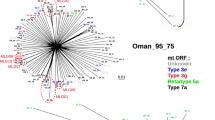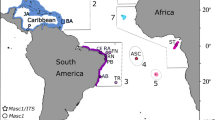Abstract
The fungiid Heliofungia actiniformis is one of the most popular scleractinian coral species in the growing live aquarium trade, with the majority of specimens originating in Indonesia. Details on population connectivity may potentially provide important information with regards to harvest management efforts. Genetic structure was examined, using ribosomal ITS1, 5.8S and partial ITS2 sequences on a small scale among populations in the Spermonde Archipelago, South Sulawesi (up to 65 km distance, Φst = 0.09), and on a large scale throughout the Indo-Malay Archipelago (up to 2,900 km distance, Φst = 0.26). Significant genetic structuring was found at both scales. Within the Spermonde Archipelago isolation by distance as well as local oceanographic features shaped patterns of genetic connectivity. On the large scale, the data revealed genetically distinct populations in Tomini Bay, New Guinea and the Thousand Islands near Jakarta, and a lack of genetic differentiation among populations lying close to or directly in the path of the Indonesian throughflow: from the central Visayas to the Flores Sea (Φct = 0.32). Whilst the influence of both historical and present day processes on genetic structuring of H. actiniformis populations was revealed, large scale results further emphasised the importance of oceanographic dynamics on larval dispersal patterns in this species. Potential for larval input from surrounding populations, and the increased vulnerability of upstream as well as isolated populations should be taken into consideration when setting future harvest quotas.



Similar content being viewed by others
References
Abe N (1937) Post-larval development of Fungia actiniformis. Palao Trop Biol Stn Stud 1:73–79
Abe N (1940) Growth of Fungia actiniformis var. palawensis Doederlein and its environmental conditions. Palao Trop Biol Stn Stud 2:105–145
Ayre DJ, Dufty S (1994) Evidence for restricted gene flow in the viviparous coral Seriatopora hystrix on Australia’s Great Barrier Reef. Evolution 48(4):1183–1201
Ayre DJ, Hughes TP (2000) Genotypic diversity and gene flow in brooding and spawning corals along the Great Barrier Reef, Australia. Evolution 54:1590–1605
Ayre DJ, Hughes TP, Standish RJ (1997) Genetic differentiation, reproductive mode, and gene flow in the brooding coral Pocillipora damicornis along the Great Barrier Reef, Australia. Mar Ecol Prog Ser 159:175–187
Barber PH, Palumbi SR, Erdmann MV, Moosa KM (2000) Biogeography: a marine Wallace’s line? Nature 406:692–693
Barber PH, Palumbi SR, Erdmann MV, Kasim Moosa M (2002) Sharp genetic breaks among populations of Haptosquilla pulchella (Stomatopoda) indicate limits to larval transport: patterns, causes, and consequences. Mol Ecol 11:659–674
Barber PH, Erdmann MV, Palumbi SR (2006) Comparative phylogeography of three codistributed stomatopods: origins and timing of regional lineage diversification in the coral triangle. Evolution 60(9):1825–1839
Benzie JAH (1999) Genetic structure of coral reef organisms: ghosts of dispersal past. Am Zool 39:131–145
Benzie JAH, Ballment E, Forbes AT, Demetriades NT, Sugama K, Haryanti, Moria S (2002) Mitochondrial DNA variation in the Indo-Pacific populations of the giant tiger prawn Panaeus monodon. Mol Ecol 11:2553–2569
Bernardi G, Holbrook SJ, Schmitt RJ (2001) Gene flow at three spatial scales in a coral reef fish, the three spot dascyllus, Dascyllus trimaculatus. Mar Biol 138:457–465
Clement M, Posada D, Crandall KA (2000) TCS: a programme to estimate gene genealogies. Mol Ecol 9:1657–1660
De Klerk LG (1983) Sea levels, reefs and coastal plains of Southwest Sulawesi, Indonesia; a morphogenetic-pedological study. Dissertation, State University of Utrecht
Duda TF Jr, Palumbi SR (1999) Population structure of the black tiger prawn Panaeus monodon, among western Indian Ocean and western Pacific populations. Mar Biol 134:705–710
Excoffier L, Laval G, Schneider S (2005) Arlequin version 3.0: an integrated software package for population genetics data analysis. Bioinform Online 1:47–50
Forsman ZH, Guzman HM, Chen CA, Fox GE, Wellington GM (2005) An ITS region of Sidastrea (Cnidaria: Anthozoa): is S. glynni endangered or introduced? Coral Reefs 24(2):342–347
Gordon AL (2005) Oceanography of the Indonesian Seas and their throughflow. Oceanography 18(4):15–27
Gordon AL, Fine RA (1996) Pathways of water between the Pacific and Indian Oceans in the Indonesian seas. Nature 379:146–149
Green EP, Shirley F (1999) The global trade in corals. World Conservation Monitoring Centre, World Conservation Press, Cambridge, UK
Hall TA (1999) BioEdit: a user-friendly biological sequence alignment editor and analysis program for Windows 95/98/NT. Nucleic Acids Symp Ser 41:95–98
Hamid LMO (2007) Genetic population structure of the pink anemonefish Amphiprion perideraion (Pomacentridae) in the Indo-Malay Archipelago. MSc Dissertation, University of Bremen
Harrison PL, Wallace CC (1990) Reproduction, dispersal and recruitment of scleractinian corals. In: Dubinsky Z (Ed) Ecosystems of the World, vol 25. Coral reefs Elsevier Science Publishers, Amsterdam, pp 133–207
Haq BU, Hardenbol J, Vail PR (1987) Chronology of fluctuating sea levels since the Triassic. Science 235:1156–1167
Hoeksema BW (2007) Delineation of the Indo-Malayan centre of maximum marine biodiversity: the coral triangle. In: Renema W (ed) Biogeography, time and place: distributions, barriers and islands, Topics in geobiology vol 29. pp 117–178
Hughes TP, Bellwood DR, Connnolly SR (2002) Biodiversity hotspots, centres of endemicity, and the conservation of coral reefs. Ecol Lett 5:773–784
Jensen JL, Bohonak AJ, Kelley ST (2005) Isolation by distance, web service. BioMed Cent Genet 6:13
Kimura M, Weiss GH (1964) The stepping stone model of population structure and the decrease of genetic correlation with distance. Genetics 49:561–576
Kochzius M, Nuryanto A (2008) Strong genetic population structure in the boring giant clam Tridacna crocea across the Indo-Malay Archipelago: implications related to evolutionary processes and connectivity. Mol Ecol, in press
Kochzius M, Hauschild J, Kirchhoff S, Meyer-Wachsmuth I, Seidel C (2006) Congruence of genetic population structure in the blue starfish Linckia laevigata and its parasite Thyca crystallina in the central Indo-Malay Archipelago? In: Abstracts of the 6th European meeting of the International Society for Reef Studies (ISRS), Bremen, Germany, pp 19–22
Lourie SA, Green DM, Vincent ACJ (2005) Dispersal, habitat differences, and comparative phylogeography of Southeast Asian seahorses (Syngnathidae: Hippocampus). Mol Ecol 14:1073–1094
Lucas JS (1994) The biology, exploitation and mariculture of giant clams (Tridacnidae). Rev Fish Sci 2:181–223
Magalon H, Adjeroud M, Veuille M (2005) Patterns of genetic variation do not correlate with geographical distance in the reef-building coral Pocillopora meandrina in the South Pacific. Mol Ecol 14:1861–1868
Manly BJF (1994) Multivariate statistical methods: a primer. Chapman and Hall, New York
Miller KJ, Ayre DJ (2004) The role of sexual and asexual reproduction in structuring high latitude populations of the reef coral Pocillopora damicornis. Heredity 92:557–568
Nei M (1987) Molecular evolutionary genetics. Columbia University Press, New York
Nelson JS, Hoddell RJ, Chou LM, Chan WK, Phang VPE (2000) Phylogeographic structure of the false clownfish, Amphiprion ocellaris, explained by sea level changes on the Sunda Shelf. Mar Biol 137:727–736
Nishikawa A, Katoh M, Kazuhiko S (2003) Larval settlement and gene flow of broadcast-spawning (Acropora tenuis) and planula-brooding (Stylophora pistillata) corals. Mar Ecol Prog Ser 256:87–97
Posada D, Crandall KA (1998) Modeltest: testing the model of DNA substitution. Bioinformatics 14:817–818
Richmond RH (1989) Competency and dispersal of spawned versus brooded coral planula larvae. Paper presented at the 6th International Coral Reef Symposium, Townsville, Australia, 8–12 September 1988
Rodriguez-Lanetty M, Hoegh-Guldberg O (2002) The phylogeography and connectivity of the latitudinally widespread scleractinian coral Pleisiastrea versipora in the Western Pacific. Mol Ecol 11:1177–1189
Spalding MD, Ravilious C, Green EP (2001) World atlas of coral reefs. UNEP World Conservation Monitoring Centre. University of California Press, Berkeley, USA
Sugama K, Haryanti , Benzie JAH, Ballment E (2002) Genetic variation and population structure of the giant tiger prawn, Penaeus monodon, in Indonesia. Aquaculture 205:37–48
Takabayashi M, Carter D, Ward S, Hoegh-Guldberg O (1998) Inter- and intra-specific variability in ribosomal DNA sequence in the internal transcribed spacer region of corals. In: Greenwood JG, Hall NJ (eds) Proceedings of the Australian Coral Reef Society 75th Anniversary Conference, The University of Queensland, Brisbane, 1997
Thompson JG, Higgins DG, Gibson TJ (1994) CLUSTAL W: improving the sensitivity of progressive multiple sequence alignments through sequence weighting, position specific gap penalties and weight matrix choice. Nucleic Acids Res 22:4673–4680
Timm J, Kochzius M (2006) Strong genetic structure and limited gene flow between populations of the False Clown Anemonefish (Amphiprion ocellaris) in the Indo-Malay Archipelago. In: Abstracts of the 6th European meeting of the International Society for Reef Studies (ISRS), Bremen, Germany, 19–22 September 2006
Tomascik T, Mah AJ, Nontji A, Moosa MK (1997) The ecology of the Indonesian Seas part one. The ecology of Indonesia series volume VII. Periplus, Singapore
Veron JEN (2000) Corals of the world. AIMS Townsville, Australia
Vollmer SV, Palumbi SR (2007) Restricted gene flow in the Caribbean staghorn coral Acropora cervicornis: implications for the recovery of endangered reefs. J Hered 98(1):40–50
Voris HK (2000) Maps of Pleistocene sea levels in Southeast Asia: shorelines, river systems, time durations. J Biogeogr 27:1153–1167
Wabnitz C, Taylor M, Green E, Razak T (2003) From ocean to aquarium. UNEP-WCMC, Cambridge, UK
Wallace CC (1997) The Indo-Pacific centre of coral diversity re-examined at species level. In: Proceedings of the 8th International Coral Reef Symposium, Panama, 24–29 June 1997
Wallace CC, Paulay G, Hoeksema BW, Bellwood DR, Hutchings PA, Barber PH, Erdmann M, Wolstenholme J (2003) Nature and origins of unique high diversity reef faunas in the Bay of Tomini, Central Sulawesi: The ultimate ‘centre of diversity’? In: Proceedings of the 9th International Coral Reef Symposium, Bali, 23–29 October 2000
White TJ, Bruns T, Lee S, Taylor WJ (1990) Amplification and direct sequencing of fungal ribosomal RNA genes for phylogenetics. In: Innis MA, Gelfand DH, Sninsky JJ, White TJ (Eds) PCR protocols: a guide to methods and applications, Academic Press, San Diego, pp 315–322
Walsh PS, Metzger DA, Higuchi R (1991) Chelex-100 as a medium for simple extraction of DNA for PCR based typing from forensic material. Biotechniques 10:506–513
Williams ST, Benzie JAH (1996) Genetic uniformity of widely separated populations on the coral reef starfish Tinckia laevigata from the East Indian and West Pacific Oceans, revealed by allozyme electrophoresis. Mar Biol 126:99–107
Williams ST, Benzie JAH (1998) Evidence of a biogeographic break between populations of a high dispersal starfish: congruent regions within the Indo-West Pacific defined by colour morphs, mtDNA, and allozyme data. Evolution 52(1):87–99
Wilson JR, Harrison PL (1998) Settlement-competency periods of larvae of three species of scleractinian corals. Mar Biol 131:339–345
Wyrtki K (1961) Physical oceanography of the Southeast Asian waters. Naga Report 2, Scripps Institution of Oceanography, p 195
Acknowledgements
We would like to thank staff and students at the Centre for Coral Reef Research of Hasanuddin University (UNHAS) in Makassar, Indonesia, for invaluable help and advice with logistics, especially J. Jompa. We also thank B. Marit and H. Jalil for assistance with sample collection at Pulau Sembilan and Pulau Seribu. This study is part of the SPICE (Science for the Protection of Indonesian Coastal Ecosystems) Project, conducted and permitted under bilateral governmental agreements between the German Federal Ministry of Education and Research (BMBF), and the Indonesian Ministry for Research and Technology (RISTEK) / the Indonesian Institute of Sciences (LIPI) / the Indonesian Ministry of Maritime Affairs and Fisheries (DKP) / the Indonesian Agency for the Assessment and Application of Technology (BPPT). Funding was provided by the German Ministry of Education and Research (BMBF grant numbers 03F0390A and 03F0390B). The collection of samples in Tomini Bay and New Guinea was made possible by research expeditions financed by UNHAS Wallacea Institute and GEO Magazine (Hamburg, Germany) respectively.
Author information
Authors and Affiliations
Corresponding author
Rights and permissions
About this article
Cite this article
Knittweis, L., Kraemer, W.E., Timm, J. et al. Genetic structure of Heliofungia actiniformis (Scleractinia: Fungiidae) populations in the Indo-Malay Archipelago: implications for live coral trade management efforts. Conserv Genet 10, 241–249 (2009). https://doi.org/10.1007/s10592-008-9566-5
Received:
Accepted:
Published:
Issue Date:
DOI: https://doi.org/10.1007/s10592-008-9566-5




